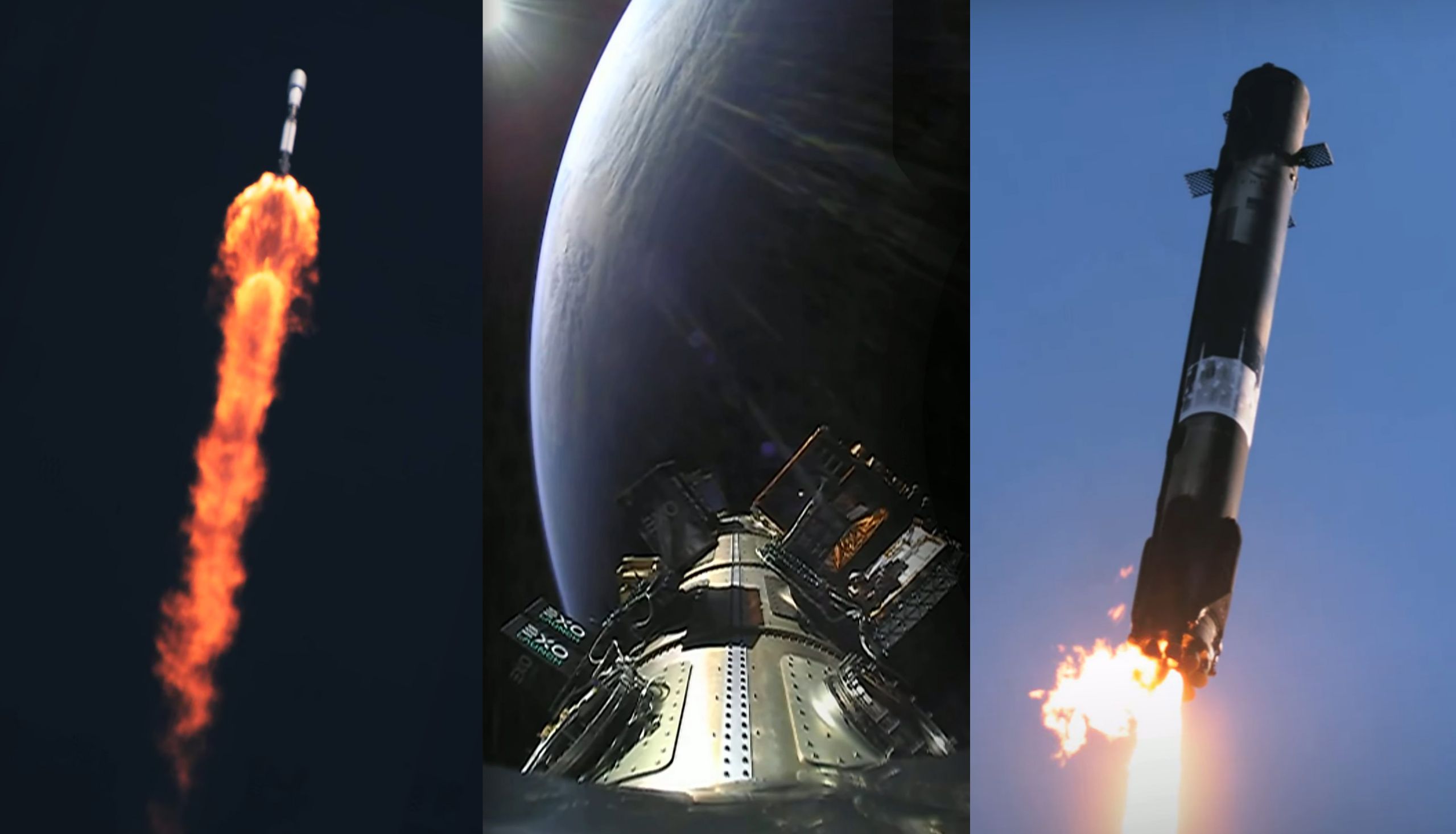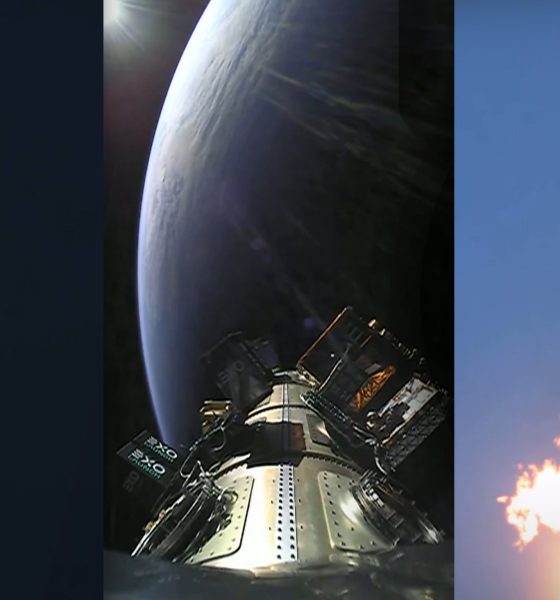

News
SpaceX kicks off 2023 with second largest rideshare launch
After rounding out 2022 with the world’s last orbital launch, SpaceX has kicked off 2023 with the new year’s first orbital launch – also the second-largest rideshare mission in history.
At 9:56 am EST (14:56 UTC), a SpaceX Falcon 9 rocket lifted off on Transporter-6, the sixth dedicated launch under the company’s Smallsat Rideshare Program. SpaceX says Transporter-6 deployed 114 payloads for dozens of paying customers, making it the second-largest rideshare mission ever launched. In addition, marking the latest apogee of a growing cottage industry largely enabled by SpaceX’s affordable and regular rideshare launch services, Transporter-6 carried an unprecedented number of ‘space tugs’ developed by five separate companies.
The update that's rolling out to the fleet makes full use of the front and rear steering travel to minimize turning circle. In this case a reduction of 1.6 feet just over the air— Wes (@wmorrill3) April 16, 2024
At a minimum, Transporter-6’s expansive payload roster included Launcher’s first Orbiter space tug, Epic Aerospace’s first CHIMERA space tug, Momentus Space’s second Vigoride space tug, and two D-Orbit ION space tugs. While their capabilities vary significantly, all of the space tags or transfer vehicles manifested on the mission have a similar purpose: transporting satellites launched as rideshare payloads from their rocket’s one-size-fits-all parking orbit to an orbit more optimized for each spacecraft’s mission.
In theory, that concept could eventually take the shape of a service that lets operators send their satellites to a wide variety of orbits and still take advantage of the savings enabled by rideshare launches – particularly from SpaceX. But that time has not quite come. At the moment, only a few providers have successfully demonstrated space tugs with propulsion systems, and most of those proven options only allow for small orbit tweaks. One tug built by Spaceflight has partially demonstrated the ability to climb from ~300 kilometers to more than 1000 kilometers. Rocket Lab’s Electron kick stage is arguably the most successful in low Earth orbit, and the company has also shown that Photon – an upgraded version of that kick stage – can send payloads to high Earth orbits or even the Moon.
Future tugs could enable routine changes on the order of hundreds or even thousands of kilometers for multiple payloads per flight. Many prospective providers – including Momentus and Epic – hope to follow up their simpler prototypes (and follow in Rocket Lab’s footsteps) with tugs capable of carrying satellites to high Earth orbits, the Moon, and deep space.
SpaceX’s Transporter missions and the space tugs that frequent them all serve the same purpose: getting satellites where they need to go for a diverse range of customers. And Transporter-6 deployed a number of interesting payloads. In partnership with Nanoavionics, French startup Gama launched its first solar sail prototype in the hopes of one day lowering the cost of deep space propulsion and exploration. Momentus will get a second opportunity to demonstrate its Vigoride tug, which is powered by an exotic water plasma propulsion system. Spire launched the first prototypes of an upgraded satellite bus. Orbital Sidekick launched its first Earth observation satellite. Lynk Global launched an in-space cell tower to test the ability to broadcast 5G from space to the ground. Australian startup Skykraft launched its first batch of Block 2 air traffic management satellites and will deploy them with its own free-flying “Deployer 1” – essentially a space tug without propulsion. Planet launched dozens of new SuperDove Earth-imaging satellites. And Ukrainian startup EOS launched Agrisat-1, the country’s first commercial satellite.
Following Transporter-6, SpaceX’s Smallsat Rideshare Program has launched approximately 566 payloads in less than two years. In addition, SpaceX has launched more than 3600 of its own Starlink satellites since November 2019 for a total of well over 4000 satellites launched in a little over three years.
Prior to the end of 2022, SpaceX had never launched a rocket later than December 23rd or earlier than January 6th. That odd gap finally fell at the end of SpaceX’s record-breaking 2022 performance, which saw the company ace 61 Falcon launches in a single calendar year. Transporter-6 will be SpaceX and the world’s first launch of 2023. Never one to stand still, CEO Elon Musk has set SpaceX a target of “up to 100 launches” in the new year.
Rewatch SpaceX and the world’s first orbital launch (and rocket landing) of 2023 below.

News
Tesla China delivery centers look packed as 2025 comes to a close
Needless to say, it appears that Tesla China seems intent on ending 2025 on a strong note.

Tesla’s delivery centers in China seem to be absolutely packed as the final days of 2025 wind down, with photos on social media showing delivery locations being filled wall-to-wall with vehicles waiting for their new owners.
Needless to say, it appears that Tesla China seems intent on ending 2025 on a strong note.
Full delivery center hints at year-end demand surge
A recent image from a Chinese delivery center posted by industry watcher @Tslachan on X revealed rows upon rows of freshly prepared Model Y and Model 3 units, some of which were adorned with red bows and teddy bears. Some customers also seem to be looking over their vehicles with Tesla delivery staff.
The images hint at a strong year-end push to clear inventory and deliver as many vehicles as possible. Interestingly enough, several Model Y L vehicles could be seen in the photos, hinting at the demand for the extended wheelbase-six seat variant of the best-selling all-electric crossover.
Strong demand in China
Consumer demand for the Model Y and Model 3 in China seems to be quite notable. This could be inferred from the estimated delivery dates for the Model 3 and Model Y, which have been extended to February 2026 for several variants. Apart from this, the Model Y and Model 3 also continue to rank well in China’s premium EV segment.
From January to November alone, the Model Y took China’s number one spot in the RMB 200,000-RMB 300,000 segment for electric vehicles, selling 359,463 units. The Model 3 sedan took third place, selling 172,392. This is quite impressive considering that both the Model Y and Model 3 are still priced at a premium compared to some of their rivals, such as the Xiaomi SU7 and YU7.
With delivery centers in December being quite busy, it does seem like Tesla China will end the year on a strong note once more.
News
Tesla Giga Berlin draws “red line” over IG Metall union’s 35-hour week demands
Factory manager André Thierig has drawn a “red line” against reducing Giga Berlin’s workweek to 35 hours, while highlighting that Tesla has actually increased its workers’ salaries more substantially than other carmakers in the country.

Tesla Giga Berlin has found itself in a new labor dispute in Germany, where union IG Metall is pushing for adoption of a collective agreement to boost wages and implement changes, such as a 35-hour workweek.
In a comment, Giga Berlin manager André Thierig drew a “red line” against reducing Giga Berlin’s workweek to 35 hours, while highlighting that Tesla has actually increased its workers’ salaries more substantially than other carmakers in the country.
Tesla factory manager’s “red line”
Tesla Germany is expected to hold a works council election in 2026, which André Thierig considers very important. As per the Giga Berlin plant manager, Giga Berlin’s plant expansion plans might be put on hold if the election favors the union. He also spoke against some of the changes that IG Metall is seeking to implement in the factory, like a 35-hour week, as noted in an rbb24 report.
“The discussion about a 35-hour week is a red line for me. We will not cross it,” Theirig said.
“(The election) will determine whether we can continue our successful path in the future in an independent, flexible, and unbureaucratic manner. Personally, I cannot imagine that the decision-makers in the USA will continue to push ahead with the factory expansion if the election results favor IG Metall.”
Giga Berlin’s wage increase
IG Metall district manager Jan Otto told the German news agency DPA that without a collective agreement, Tesla’s wages remain significantly below levels at other German car factories. He noted the company excuses this by referencing its lowest pay grade, but added: “The two lowest pay grades are not even used in car factories.”
In response, Tesla noted that it has raised the wages of Gigafactory Berlin’s workers more than their German competitors. Thierig noted that with a collective agreement, Giga Berlin’s workers would have seen a 2% wage increase this year. But thanks to Tesla not being unionized, Gigafactory Berlin workers were able to receive a 4% increase, as noted in a CarUp report.
“There was a wage increase of 2% this year in the current collective agreement. Because we are in a different economic situation than the industry as a whole, we were able to double the wages – by 4%. Since production started, this corresponds to a wage increase of more than 25% in less than four years,” Thierig stated.
News
Tesla is seeing a lot of momentum from young Koreans in their 20s-30s: report
From January to November, young buyers purchased over 21,000 Teslas, putting it far ahead of fellow imported rivals like BMW and Mercedes-Benz.

Tesla has captured the hearts of South Korea’s 20s-30s demographic, emerging as the group’s top-selling imported car brand in 2025. From January to November, young buyers purchased over 21,000 Teslas, putting it far ahead of fellow imported rivals like BMW and Mercedes-Benz.
Industry experts cited by The Economist attributed this “Tesla frenzy” to fandom culture, where buyers prioritize the brand over traditional car attributes, similar to snapping up the latest iPhone.
Model Y dominates among young buyers
Data from the Korea Imported Automobile Association showed that Tesla sold 21,757 vehicles to the 20s-30s demographic through November, compared to BMW’s 13,666 and Mercedes-Benz’s 6,983. The Model Y led the list overwhelmingly, with variants like the standard and Long Range models topping purchases for both young men and women.
Young men bought around 16,000 Teslas, mostly Model Y (over 15,000 units), followed by Model 3. Young women followed a similar pattern, favoring Model Y (3,888 units) and Model 3 (1,083 units). The Cybertruck saw minimal sales in this group.
The Model Y’s appeal lies in its family-friendly SUV design, 400-500 km range, quick acceleration, and spacious cargo, which is ideal for commuting and leisure. The Model 3, on the other hand, serves as an accessible entry point with lower pricing, which is valuable considering the country’s EV subsidies.
The Tesla boom
Experts described Tesla’s popularity as “fandom culture,” where young buyers embrace the brand despite criticisms from skeptics. Professor Lee Ho-geun called Tesla a “typical early adopter brand,” comparing purchases to iPhones.
Professor Kim Pil-soo noted that young people view Tesla more as a gadget than a car, and they are likely drawn by marketing, subsidies, and perceived value. They also tend to overlook news of numerous recalls, which are mostly over-the-air software updates, and controversies tied to the company.
Tesla’s position as Korea’s top import for 2025 seems secured. As noted by the publication, Tesla’s December sales figures have not been reported yet, but market analysts have suggested that Tesla has all but secured the top spot among the country’s imported cars this year.








